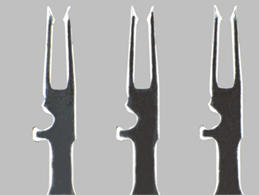Conventionally, Sn-10%Pb solder plating, melting at a low point of 183°C, would be used, but because lead-containing solder plating has become unusable according to an RoHS Directive, reflow tin plating, Sn-Cu alloy plating, Sn-Bi alloy plating, and Sn-Ag alloy plating are playing more active parts as lead-free solder plating.
| Type of plating | Features | Characteristic value |
|---|---|---|
| Sn-Pb alloy plating | - Sn-10Pb alloy plating Solderability (excellent), whisker suppression (excellent) |
Melting point 212°C |
Sn-Cu alloy plating |
- Sn-3Cu alloy plating Solderability (good), whisker suppression (fair) |
Melting point 229°C |
Sn-Bi alloy plating |
- Sn-2Bi alloy plating Solderability (good), whisker suppression (good) - There are many examples of plating for legs of lead frames. |
Melting point 221°C |
Sn-Ag alloy plating |
- Sn-3.5Ag alloy plating Solderability (good), whisker suppression (good) |
Melting point 221°C |
Reflow Sn plating |
- Solderability (good), whisker suppression (excellent) - While the alloy compositions of various types of alloy plating greatly change depending on plating conditions, single plating like reflow tin plating is highly reliable precision plating having no composition variations. Recently, reflow specification of semigloss tin plating has been increasing more than alloy plating. |
Melting point 232°C |

Reflow tin plating